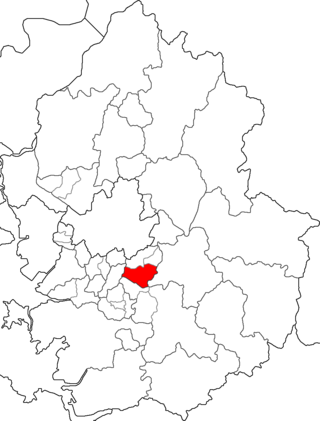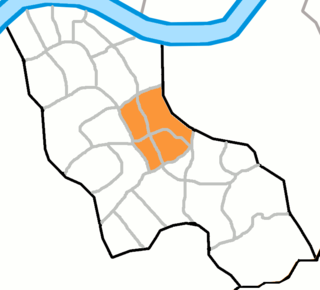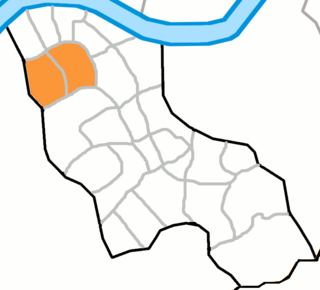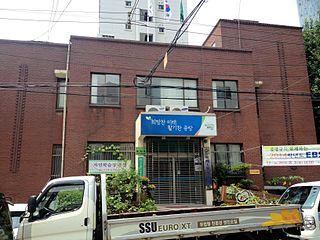
Bundang District (Korean: 분당구) is the largest and most populous district (gu) of Seongnam, a major city in the Seoul Capital Area, South Korea. Bundang District is one of South Korea's wealthiest and highest developed areas, being the nation's first and largest completely artificial city built in the early 1990s. Many high-rise luxury condos moved in the early 2000s, with a second planned city built in the late 2000s called Pangyo in the same district. Apartment prices are the second highest in Gyeonggi Province after Gwacheon and 7th highest nationwide, higher than many central Seoul districts such as Mapo District or Jongno District. Apartments around Pangyo station and the high-rise luxury condos around Jeongja station and Sunae station rival prices in the most expensive areas in the country. Unlike older cities such as Seoul, Bundang has no telephone poles overground, resulting in a clean cityscape with well-designed streets.

Yangjae Station is a station on the Seoul Subway Line 3 and Shinbundang Line. It was the southern terminus of Line 3 until October 30, 1993, when the line was extended to Suseo station, and it became a transfer station with the Shinbundang Line on October 28, 2011. It is located in Yangjae-dong, Seocho and Gangnam District, Seoul.

Apgujeong-dong is a ward of Gangnam District in Seoul, South Korea. It is considered one of the wealthiest neighborhoods in South Korea. It was reported that housing price of Apgujeong-dong is approximately US$28,300 per one square meter by Korea Ministry of Land, Infrastructure and Transport in 2019.

Daechi-dong (Korean: 대치동) is an affluent neighborhood in Gangnam District, Seoul, South Korea. Daechi-dong is divided into three different "dongs" which are Daechi 1-dong, 2-dong, and 4-dong. Daechi-dong is predominantly considered the residential area of Gangnam. As a result, real estate in the area is highly competitive and expensive compared to other parts of Gangnam. The Yangjaecheon is a stream that runs through the heart of Daechi-dong.

Pangyo or Pangyo New Town is a planned district composed of several dongs or neighborhoods of Seongnam, South Korea. It contains Pangyo-dong, Baekhyeon-dong, Unjung-dong, and Sampyeong-dong of Bundang-gu and Siheung-dong and Sasong-dong of Sujeong-gu.

Seocho-dong is a dong, or neighborhood of the greater Gangnam area Seocho-gu district of the South Korean city of Seoul. Seocho-dong is divided into 4 different dong which are Seocho 1-dong, 2-dong, 3-dong and 4-dong. The main street is Teheranno. There is Gangnam Station in Seocho-dong, which is one of the biggest stations in Korea.

Cheongdam-dong (Korean: 청담동) is a ward of Gangnam District, Seoul, South Korea. The area is best known in South Korea as an affluent neighborhood populated by a disproportionately high number of high-income individuals and for having some of the most expensive real estate in the country. It is known as an upmarket shopping area, with the main shopping street dubbed Cheongdam Fashion Street. Along with Apgujeong's Rodeo Street in Apgujeong-dong and Garosu-gil in Sinsa-dong, which are connected by the main Apgujeong-ro, they are seen as fashionable and trendsetting destinations.

Dogok-dong is an affluent ward of Gangnam District, Seoul, South Korea. It is home to high-end residential homes including the Samsung Tower Palace, a luxury residential complex which contains the eleventh-tallest building in South Korea.

Yeoksam-dong (Korean: 역삼동) is a ward of Gangnam-gu, Seoul, South Korea. Teheranno runs through Yeoksam-dong and has some of the tallest buildings in Seoul, comprising a collection of corporate headquarters and high-rise office buildings.

Samseong-Dong is an affluent neighborhood or ward of Gangnam-gu in Seoul, South Korea.

Nonhyeon-dong (Korean: 논현동) is a ward of Gangnam-gu in Seoul, South Korea. It borders Apgujeong and Sinsa-dong on the north, Samseong-dong on the northeast, and Yeoksam-dong to the south.

Gaepo-dong (Korean: 개포동) is a ward of Gangnam District, Seoul, South Korea, south of Dogok-dong and Daechi-dong. Gaepodong is divided into three "dong": Gaepo 1, 2, and 4 dong. Gaepo 3-dong had been merged with Gaepo 2-dong in 2009.

Irwon-dong is a ward of Gangnam-gu in South Korea.

Segok-dong is a ward of Gangnam-gu in Seoul, South Korea. It is the most rural neighbourhood in Gangnam-gu.

Jamwon-dong is a dong, neighbourhood of the greater Gangnam area Seocho-gu in Seoul, South Korea. Until 1988, Jamwon-dong was under the jurisdiction of Gangnam-gu. Jamwon-dong is popular for its mulberry trees and silkworms, whose cocoon is used to make fabric for clothing. As a legal-status neighborhood, Jamwon-dong includes Banpo 3-dong and Jamwon-dong.

Banpo-dong is a dong, neighborhood of Seocho District, the greater Gangnam area in Seoul, South Korea. Banpo-dong is divided into five different dong which are Banpobon-dong, Banpo 1-dong, 2-dong, 3-dong and 4-dong.

Yangjae-dong is a dong, neighbourhood of the greater Gangnam area Seocho District in Seoul, South Korea. Yangjae-dong is divided into 2 different dong which are Yangjae 1-dong and 2-dong.

Hannam-dong (Korean: 한남동) is a wealthy dong (neighborhood)of Yongsan District, Seoul, South Korea. It has been portrayed continuously in South Korea's popular culture as an oasis of wealth and luxury, thus becoming the subject of numerous domestic films, television series, and popular music references.

Muk-dong is a dong, neighbourhood of Jungnang-gu in Seoul, South Korea.
Sangam-dong is a legal dong (neighborhood) of the Mapo District in Seoul, South Korea. In the wake of the 2002 FIFA World Cup, a large apartment complex and DMC business district have been created and developed into the center of western Seoul.



















